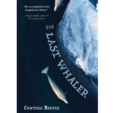The Last Whaler is a deeply moving novel that meditates on the grieving of parents following the loss of their son in an accident.
The grief of the mother, Astrid, is profound. To her lost child she says, “I long for those first blissful seconds of consciousness each morning when I wake to the thought that you’re alive, that any moment you and Birgita will run through the bedroom door and leap into bed with me and Pappa and snuggle under our warm down coverlet…. Oh, how agonizing that abrupt realization each morning that you are dead.”
Following their son’s death, Astrid insists she accompany her husband, Tor, to Svalbard, a Norwegian archipelago in the Arctic Circle, where he has a whaling station. From mid-April to August the sun shines unceasingly, but in winter darkness rules. There are many dangers, including polar bears, accidents, the brutal cold, ice crevasses, food insecurity, isolation, and the threat of sexual violence implicit in being a lone woman among men.
For these reasons, Tor resists having Astrid accompany him: “‘The point is,” Tor says, “Svalbard can break you.”
“Or heal me,” responds Astrid. “Heal us.”
They go. During their visit to the station in the summer of 1937, Astrid writes letters to her lost child.
The desolate beauty of the remote Arctic shore becomes a powerful metaphor for their struggle to survive inner turmoil and overwhelming grief. Astrid, a botanist, wants to discover a new plant and name it for Birk, to ensure that some part of him will live on.
Ten years after the Arctic trip, Tor finds Astrid’s letters to their son. When he returns to Svalbard, once again at the summer solstice, Astrid’s thoughts are revealed to the reader as he encounters them in the letters. The narrative alternates between Astrid in 1937 and Tor in 1947, and Tor responds to Astrid’s observations with the knowledge of all that has come to pass, including the Second World War.
In this way, the story of their visit to Svalbard unfolds through the two overlapping perspectives. This dual narrative structure in Reeves’ expert telling reveals how time can be suspended and cyclical, where personal and historical memory diffuse into the present. As Tor comments: “Where does time go? It disappears, leaves an echo in its wake. Or maybe, just maybe, the past unwinds parallel to the present.”
Through the alternating narratives, Reeves maintains tension and suspense even when it becomes increasingly clear what happened during the 1937 trip–transformative events that I won’t give away here. The dual narrative is reflected in other oppositions and doublings throughout the novel, such as the ever-present darkness in winter and mirrored light in summer; the threat of war and resultant peace; the precarity of the liminal space between shore and land; the suffusion of the past into the present; the necessity of death to provide sustenance for life; and the desolation of the Arctic conjoined with the omnipresent grief over the death of a child.
Although there is tragedy and sadness at the heart of the story, this is not a depressing read. There is great joy and happiness and adventure throughout. Part of the pleasure of reading The Last Whaler is seeing this remote land–one that I had never before heard of–portrayed with such richness.
Through her deep research, which included a trip to the region, and her luminous prose, Reeves meticulously recreates life in a distinctive moment and place, and she offers a richly drawn portrait of resilience in the face of stunning hardship.
Would My Pick be Your Pick?
If you're interested in ________, the answer may be "Yes":■ Stories about travel, especially to the Arctic
■ Explorations of grief and loss
■ Historical novels

